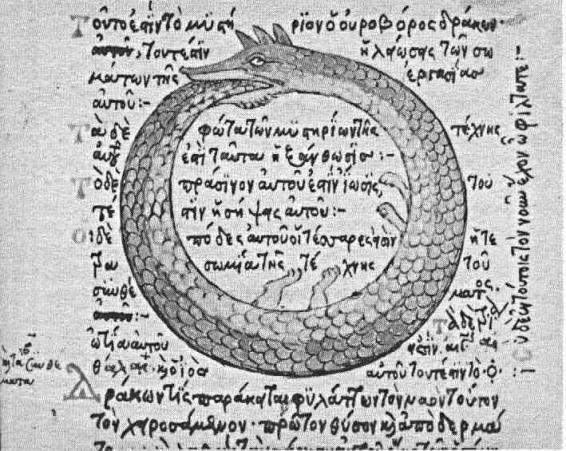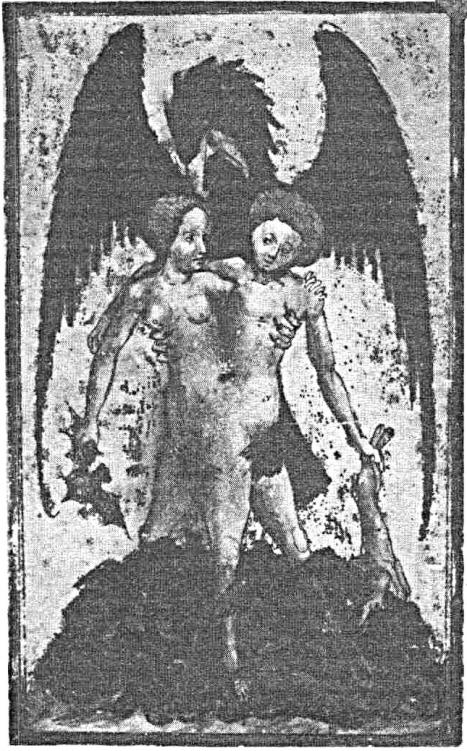The Reenchantment of the World (11 page)
Read The Reenchantment of the World Online
Authors: Morris Berman
outer, psychic and organic (or physical), do not exist. If you wish
to promote love, says Agrippa, eat pigeons; to obtain courage, lions'
hearts. A wanton woman, or charismatic man, possesses the same virtue
as a lodestone, that of attraction.10 Diamonds, on the other hand,
weaken the lodestone, and topaz weakens lust. Everything thus bears the
mark of the Creator, and knowledge, says Agrippa, consists of "a certain
participation," a (sensuous) sharing in His Divinity. This is a world
permeated with meaning, for it is according to these signatures that
everything belongs, has a place. "There is nothing found in the whole
world," he writes, "that hath not a spark of the virtue [of the world
soul]." "Every thing hath its determinate and particular place in the
exemplary world."
we have noted, magic and Hermeticism were in continual conflict with the
church. But this conflict, like the theory of knowledge that underlay it,
was also one of resemblance, for the medieval church (as we shall discuss
below) was steeped in magical practices and sacraments from which it
derived its power on the local level. Consequently, it would tolerate
no rivalry on this score.11 The important point, however, is that all
premodern knowledge had the same structure. As Michel Foucault tells us,
divination "is not a rival form of knowledge; it is part of the main body
of knowledge itself." Erudition and Hermeticism, Petrarch and Ficino,
ultimately inhabited the same mental universe.
can be dated) in the late sixteenth century, that so radically marks
off the medieval from the modern world; and nowhere is this more clearly
portrayed than in Cervantes' epic, "Don Quixote."12 The Don's adventures
are an attempt to decipher the world, to transform reality itself into a
sign. His journey is a quest for resemblances in a society that has come
to doubt their significance. Hence, that society judges him to be mad,
"quixotic." Where he sees the Shield of Mambrino, Sancho Panza can make
out only a barber's basin; where (to take the most famous example) he
perceives giants, Sancho sees only windmills. Hence the literal meaning
of 'paranoia': like knowledge. The division of psychic and material,
mind and body, symbolic and literal, has finally occurred. The madman
perceives resemblances that do not exist, that are seen as not signifying
anything at all. By 1600 he is "alienated in analogy," whereas four
or five decades earlier he was the typical educated European. For the
madman the crown makes the king, and Shakespeare captured the shift in the
definition of reality in his line, "All hoods do not monks make." Given
the meaninglessness of such associations, practices such as conjuring
could no longer be regarded as effective. "I can call spirits from the
vasty deep," says Glendower to Hotspur in "Henry IV, Part I." "Why so
can I, or so can any man," replies the latter; "But will they come when
you do call for them?"
with which we are very familiar. Glendower, on the other hand, sounds
the last chords of a world largely lost to our imaginations; a world of
resonance, resemblance, and incredible richness. Yet these chords may,
even today, echo vaguely in our subconscious minds. Before turning to
a more extended discussion of the collapse of original participation,
then, it will be worth our while to stay with it a bit longer, and see
if we cannot feel our way into this manner of thinking.
The pre-Homeric Greek, the medieval Englishman (to a lesser extent, of
course), and the present-day African tribesman know a thing precisely in
the act of identification, and this identification is as much sensual
as it is intellectual. It is a
totality
of experience: the "sensuous
intellect," if the reader can imagine such a thing. We have so lost
the ability to make this identification that we are left today with
only two experiences that consist of participating consciousness: lust
and anxiety. As I make love to my partner, as I immerse myself in her
body, I become increasingly "lost." At the moment of orgasm, I
am
the
act; there is no longer an "I" who experiences it. Panic has a similar
momentum, for if sufficiently terrified I cannot separate myself from
what is happening to me. In the psychotic (or mystic) episode, my skin
has no boundary. I am out of my mind, I have become my environment. The
essence of original participation is the
feeling
, the bodily perception,
that there stands behind the phenomena a "represented" that is of the
same nature as me -- 'mana,' God, the world spirit, and so on.13 This
notion, that subject and Object, self and other, man and environment,
are ultimately identical, is the holistic world view.
although sexual desire and panic remain the best examples. In truth --
and we shall treat this in detail in Chapter 5 -- participation is the
rule rather than the exception for modern man, although he is (unlike his
premodern counterpart) largely unconscious of it. Thus as I wrote the
first few pages of this chapter, down to this page, at least, I was so
absorbed in what I was doing that I had no sense of myself at all. The
same experience happens to me at a movie, a concert, or on a tennis
court. Nevertheless, the consciousness of official culture dictates my
"recognition" that I am not, and can never be, my experiences. Whereas
my premodern counterpart felt, and saw, that he was his experiences --
that his consciousness was not some special, independent consciousness --
I classify my own participation as some form of "recreation," and see
reality in terms of the inspection and evaluation Plato hoped men would
achieve. I thus see myself as an island, whereas my medieval or ancient
predecessor saw himself more like an embryo. And although there is no
going back to the womb, we can at least appreciate how comforting and
meaningful such a state of mind, and view of reality, truly was.
in the same world as I am, but somehow conceptualizing it differently
(i.e., incorrectly)? Doesn't the subject/object dichotomy represent a
distinct advance in human knowledge over this primitive, even orgiastic
identification of self and other? These questions, which are all
essentially asking the same thing, are the ones most crucial to the
history of consciousness, and require closer scrutiny. For there are only
two possibilities here. Either original participation, which was the basic
mode of human cognition (despite the gradual attenuation of that mode)
down to the late sixteenth century, was an elaborate self-deception; or
original participation really did exist, was an actual fact.14 We shall
try to decide between these two alternatives by means of an analysis of
the paradigm science of participation, alchemy.
attempt to find a chemical substance that, when added to lead, transformed
it into gold. Alternatively, it was the attempt to prepare a liquid,
the 'elixir vitae,' that would prolong human life indefinitely. Since
neither of these goals is attainable, the entire alchemical enterprise is
dismissed as a nonsensical episode (more than two thousand five hundred
years) in the history of science, a venture that could be viewed as tragic
were it not so silly in content. At most, modern science concedes that
the alchemists did, in the pursuit of their spurious ends, discover as
by-products various medicines and chemical substances that have some
utilitarian value.
truth. The quick production of the 'lapis,' or philosopher's stone,
whether in the form of gold or elixir, was certainly an irresistible
goal for many alchemists, and the term "puffer" was used to denote
the commercial opportunist and charlatan. "Of all men," wrote Agrippa,
"chymists are, the most perverse."15 Yet a brief perusal of medieval
and Renaissance alchemical plates, such as those collected by Carl
Jung, is enough to convince us that such charlatartry was hardly the
whole story to alchemy.16 What could these strange images (see Plates
2 - 6) possibly mean? A green and red snake swallowing its tail; an
"androgyne," or man-woman, joined at the waist with an eagle rising
behind it and a pile of dead eagles at its feet; a green lion biting
the sun, with blood (actually mercury) dripping from the resultant
"wound"; a human skeleton perched on a black sun; the sun casting a long
shadow behind the earth -- these and other images are so fantastic as
to defy comprehension. Surely, if all one wanted was health or wealth,
there was no need for the painstaking preparation of such elaborately
illustrated manuscripts. Mythopoeic artwork of this sort forces us to
abandon the simplistic utilitarian interpretation of alchemy and try,
instead, to chart the totally unfamiliar terrain of consciousness that
this bizarre imagery represents.
alchemy by means of clinical material from dream analysis, and then on
this basis to formulate the argument that alchemy was, in essence, a map
of the human unconscious. Central to Jungian psychology is the concept of
"individuation," the process whereby a person discovers and evolves his
Self, as opposed to his ego. The ego is a persona, a mask created and
demanded by everyday social interaction, and, as such, it constitutes
the center of our conscious life, our understanding of ourselves through
the eyes of others. The Self, on the other hand, is our true center,
our awareness of ourselves without outside interference, and it is
developed by bringing the conscious and unconscious parts of our mind
into harmony. Dream analysis is one way of achieving this harmony. We
can unlock our dream symbols and then act on the messages of our dreams
in waking life, which in turn begins to alter our dreams. But how to
analyze our dreams? They are frequently cryptic, and so often violate
causal sequence as to border on gibberish. But it is precisely here,
Jung discovered, that alchemy can make a crucial contribution. In fact,
it is by something like the doctrine of signatures that we are able to
figure out what our dreams mean.17

Plate 2. The Ourobouros, symbol of integration. Synosius, Ms. grec
2327, f.279. Phot. Bibl. nat. Paris.
which I have termed "dialectical," as opposed to the critical reason
characteristic of rational, or scientific, thought.18 As we saw earlier,
Descartes regarded dreams as perverse because they violated the principle
of noncontradiction. But this violation is not arbitrary; rather,
it emerges from a paradigm of its own, one that could well be called
alchemical. This paradigm has as a central tenet the notion that reality
is paradoxical, that things and their opposites are closely related, that
attachment and resistance have the same root. We know this on an intuitive
level already, for we speak of love-hate relationships, recognize that
what frightens us is most likely to liberate us, and become suspicious if
someone accused of wrongdoing protests his or her innocence too hotly. In
short, a thing can both be and not be at the same time, and as Jung,
Freud, and apparently the alchemists all understood, it usually is.

Other books
I Speak For This Child: True Stories of a Child Advocate by Gay Courter
Byron Easy by Jude Cook
Reunion Pass: An Eternity Springs novel by Emily March
Triple Stud by Tawny Taylor
The Chase, Volume 4 by Jessica Wood
She Said Yes! by Shawna Jeanne
The Enchantress of Florence by Salman Rushdie
The Old House by Willo Davis Roberts
Peter Pan Must Die by John Verdon
Seduce Me Please by Nichole Matthews